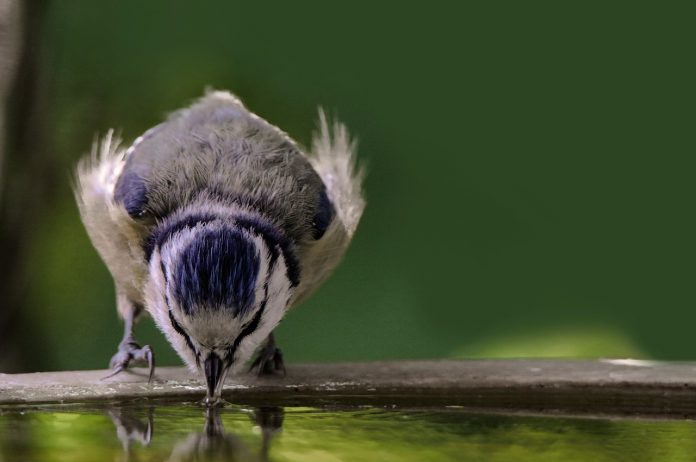So you have a bird feeder or two and you’ve tested out a few different bird seed mixes. Maybe you even have a few birdhouses hanging up around your yard. Now, you’re contemplating the next step in making your yard even more inviting to backyard birds — adding a birdbath.
Providing drinking and bathing water for birds is an easy way to attract more birds to your yard. You won’t have to invest a lot of time or money in a birdbath. Simple, inexpensive designs can have just as much success as elaborate ones, and birdbaths don’t require a lot of maintenance. The key to success is providing an ideal setup for the birds and conditions in your backyard.
Types of birdbaths
Just as different types of birds prefer different types of feeders, different types of birds prefer different types of birdbaths. Some species of birds like to bathe in pedestals or hanging birdbaths. Other species of birds seek out baths at or near ground level.
Generally speaking, a bird’s bathing preferences will reflect its feeding preferences. The birds that prefer a suspended birdbath setup are the same ones that like to feed at hanging feeders. The birds that feed at ground level are the same ones that will bathe at ground level.
Providing both types of birdbaths allows you to provide water for the widest variety of bird species and other wildlife. While suspended birdbaths attract your favorite songbirds, ground-level baths can attract less common backyard bird species and many other animal species, such as chipmunks and squirrels.
Choosing a birdbath
The material the birdbath is made out of influences price and appeal.
Terra cotta birdbaths. Inexpensive and desirable. Hanging terra-cotta birdbaths are one of the cheaper options and are preferred by birds for their rough surface.
Concrete birdbaths. Moderately priced and desirable. Like terra-cotta birdbaths, concrete birdbaths are appealing to birds because of their rough texture.
Iron or aluminum birdbaths. Expensive and less desirable. While these fancy baths might be more pleasing to the human eye, birds are not as impressed with their smoother surfaces.
Homemade birdbaths. Cost and appeal are determined in the selection of materials. You may decide to make your own birdbath from a garbage can lid or large terra-cotta plant saucer to put on the ground or hang from a tree, using rope or chains. However, if you’re utilizing glazed pottery or smooth plastics in your design, you may want to consider providing a nonstick surface. Birds don’t like slippery surfaces. You can use small rocks and bathtub stickers to create a nonstick surface.
Water
Water level. Birds will only use a birdbath if it’s shallow. Keep the water level to 2-3 inches deep.
Dripping water features. A dripper adds water to a birdbath slowly from above. You can purchase one from a garden center or make your own out of a plastic bottle or jug. Just fill your container with water and make a tiny hole in the bottom. Once you’ve established a slow drip, hang the container above your birdbath. Refill daily.
Misting water features. A mister is another water feature many birds enjoy, especially hummingbirds. You can purchase misters at garden centers.
Location
Cover. Place your birdbath near cover, so its visitors have a safe place to drink and bathe. Shrubs and low tree branches provide cover from aerial predators.
Shade. Placing your birdbath near a shady location ensures the water temperature won’t increase too much and keeps algae levels low.
Away from cat hiding places. If cats are prevalent in your yard, place your birdbath where birds can see predators approaching — 10-15 feet from the nearest predator hiding spot.
Away from feeders. Never place your birdbath under your feeder. Food and droppings will accumulate quickly.
Cleaning
Water. Change the water in your birdbath daily to prevent dirt and debris from accumulating. A daily water change also prevents mosquito larvae from hatching in your birdbath.
Birdbath. Clean your birdbath with a scrub brush and mild soap to remove algae once a week.












My wife and I want to get a birdbath for our backyard. We found it helpful when you mentioned that it is a good idea to place the bath in an area with shade. These tips you shared will help us to make sure we provide a good environment for the birds we attract.
Thanks to your article, I realized that location plays an important role in where we install our birdbath, especially in ensuring their safety. My neighbor has cats as pets, and I was wondering how it might affect my interest in putting up a birdbath in my backyard. So, I appreciate that you advised us to install our birdbaths at least 15 feet away from their usual hiding spots.
I have two birdbaths which are used constantly. They are heated and are made of heavy plastic on a pedestal. Of course, I only plug them in when things start to freeze. I am sure, I keep the Eastern Bluebirds all year round cause they drink and bathe in them on the coldest days!!